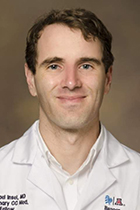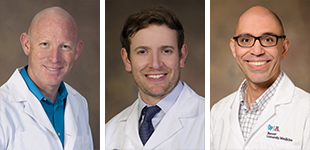 Michael B. Insel, MD, a University of Arizona assistant professor in the Division of Pulmonary, Allergy, Critical Care and Sleep Medicine, one of 14 divisions in the UA Department of Medicine, the largest department of the UA College of Medicine - Tucson, has been named a winner of an inaugural Pulmonary Hypertension Accelerated Bayer (PHAB) Award from Bayer A.G.
Michael B. Insel, MD, a University of Arizona assistant professor in the Division of Pulmonary, Allergy, Critical Care and Sleep Medicine, one of 14 divisions in the UA Department of Medicine, the largest department of the UA College of Medicine - Tucson, has been named a winner of an inaugural Pulmonary Hypertension Accelerated Bayer (PHAB) Award from Bayer A.G.
![Illustrations depicting pulmonary hypertension and pulmonary embolism [SOURCE: BruceBlaus/Wikipedia and Christy Krames Medical Illustrations] Illustrations depicting pulmonary hypertension and pulmonary embolism [SOURCE: BruceBlaus/Wikipedia and Christy Krames Medical Illustrations]](https://deptmedicine.arizona.edu/sites/default/files/ph-pe-graphic_300x375px.jpg) “This is the first year these awards/grants are being conducted as part of Bayer’s commitment to pulmonary research. Dr. Insel is receiving a $100,000 grant award for his work on the different causes of shortness of breath in patients who have suffered a pulmonary embolism (a sudden blockage in a lung artery) using invasive cardiopulmonary exercise testing,” said David Patti, deputy director of U.S. Pharmaceuticals Product Communications for Bayer U.S. LLC.
“This is the first year these awards/grants are being conducted as part of Bayer’s commitment to pulmonary research. Dr. Insel is receiving a $100,000 grant award for his work on the different causes of shortness of breath in patients who have suffered a pulmonary embolism (a sudden blockage in a lung artery) using invasive cardiopulmonary exercise testing,” said David Patti, deputy director of U.S. Pharmaceuticals Product Communications for Bayer U.S. LLC.
Bayer announced the PHAB Awards Program in May to support clinical research in pulmonary hypertension, with a focus on PAH and chronic thromboembolic pulmonary hypertension (CTEPH). The program will award up to a total of $1 million in grants over a two-year cycle.
Illustration (right) depicts pulmonary hypertension and pulmonary embolism [SOURCE: BruceBlaus/Wikipedia & Krames Medical Illustrations]
 "We believe that more can be done to develop more effective treatments for these chronic and often debilitating conditions, and to improve overall care for patients for whom every moment counts," said Aleksandra Vlajnic, MD, vice president of medical affairs at Bayer.
"We believe that more can be done to develop more effective treatments for these chronic and often debilitating conditions, and to improve overall care for patients for whom every moment counts," said Aleksandra Vlajnic, MD, vice president of medical affairs at Bayer.
Up to eight awardees, including Dr. Insel, were invited to a presentation dinner and ceremony at CHEST 2019, the annual meeting of the American College of Chest Physicians, Oct. 19-23, in New Orleans.
Pulmonary hypertension, also known as pulmonary arterial hypertension, (PA/PAH) involves high blood pressure in the pulmonary arteries from disease of the medium and small-sized vessels in the lungs that have narrowed and suffer from decreased blood flow. This condition makes it harder to breathe and forces the heart to work harder, which can eventually lead to heart failure.
CTEPH is another form of PH that originates from pulmonary embolisms. Pulmonary embolisms occur when a blood clot, usually one in the leg called a deep vein thrombosis, breaks loose and travels through the bloodstream to the lung, creating a sudden blockage in an artery. While a precise number is unclear, as many as 900,000 people could be affected by this with up to 100,000 dying from it each year. One-in-25 people suffering a pulmonary embolism develop CTEPH.
Dr. Insel, who joined the UA College of Medicine – Tucson faculty after completing his fellowship in pulmonary and critical care medicine here this past summer, is looking not so much at cases where an embolism leads to CTEPH, but those where blood flow is impaired causing shortness of breath and fatigue—and how to predict that likelihood.
“We know that 30 percent of people after a pulmonary embolism develop chronic shortness of breath and only 2-5 percent develop pulmonary hypertension,” he said.
“Shortness of breath by pulmonary embolism is multi-factorial and not well understood and only a small proportion get pulmonary hypertension. So, questions remain over what contributes to the shortness of breath that many people develop after pulmonary embolism and if it’s a precursor to pulmonary hypertension or another pulmonary disease.”
Subjects in his study will  undergo right heart catheterization during exercise to analyze various factors in their condition. Some may undergo V/Q (ventilation/perfusion) scans to image air and blood flow in the lungs.
undergo right heart catheterization during exercise to analyze various factors in their condition. Some may undergo V/Q (ventilation/perfusion) scans to image air and blood flow in the lungs.
He thanked his co-investigators in helping him to win the PHAB Award, including Franz Rischard, DO, a UA associate professor and director of the Pulmonary Hypertension Program; Gregory J. Woodhead, MD, PhD, a UA interventional radiologist and assistant professor of medical imaging; and Tammer Y. El Aini, MD, a UA assistant professor in pulmonary medicine.
EXTRA INFO: Pulmonary Hypertension, CTEPH & DVT/PE
According to the National Organization of Rare Diseases, pulmonary hypertension or pulmonary arterial hypertension (PH/PAH) affects women 3-5 times more often than men, usually between the ages of 30 and 60. There are between 500 and 1,000 new U.S. cases diagnosed each year. No racial or ethnic group is known to suffer a higher incidence of the disease.
Main causes of PH/PAH include: left heart disease (cardiomyopathy), lung disease, blood clots in the lung, and miscellaneous comorbidities such as such as kidney disease, sarcoidosis, etc. It is a common complication of chronic obstructive pulmonary disease (COPD), interstitial lung disease (ILD), and combined pulmonary fibrosis and emphysema (CPFE).
PH/PAH survival rates and life expectancy following diagnosis—commonly 3-5 years when PAH was first identified in the late 1800s—has been extended for some to 10 years and longer based on earlier diagnosis and treatment.
What is high blood pressure? (factsheet) | English – Español
For more on PAH, see: NIH/NHLBI | U.S. National Library of Medicine | MedlinePlus | CDC | American Heart Association | Pulmonary Hypertension Association
Chronic thromboembolic pulmonary hypertension (CTEPH) is high blood pressure in the arteries of the lungs caused by pulmonary embolisms (or blood clots) in patients that last at least three months after diagnosis and treatment with blood thinners. About 5,000 Americans are diagnosed with CTEPH each year. Twenty-five percent of sufferers have never been diagnosed with a blood clot.
Among risk factors that can lead to CTEPH, are:
- cancer
- a family history of embolisms
- fractures of the leg or hip
- previous pulmonary embolisms
- a history of heart attack or stroke
- major surgery, particularly joint replacement surgery
- obesity
- sedentary lifestyle
- age above 60 years
- taking estrogen or testosterone
- smoking.
Prompt treatment of Deep Vein Thrombosis and Pulmonary Embolism (DVT/PE) with blood thinners and other drugs or procedures to break up the clot greatly reduces the risk of death. Many blood clots dissolve within a matter of days with proper treatment. Surgical procedures can assist in their removal. Compression stockings and physical activity can help prevent the clots from forming in the first place.
For more on PE/CTEPH, see: American Thoracic Society (PE/CTEPH) | American Lung Association | WebMD | HealthLine | CHEST Foundation
About the UA College of Medicine –Tucson
The University of Arizona College of Medicine – Tucson is shaping the future of medicine through state-of-the-art medical education programs, groundbreaking research and advancements in patient care in Arizona and beyond. Founded in 1967, the college boasts more than 50 years of innovation, ranking among the top medical schools in the nation for research and primary care. Through the university’s partnership with Banner Health, one of the largest nonprofit health care systems in the country, the college is leading the way in academic medicine. For more information, visit medicine.arizona.edu
About Bayer
Bayer is a global enterprise with core competencies in the life science fields of health care and nutrition. Its products and services are designed to benefit people by supporting efforts to overcome the major challenges presented by a growing and aging global population. At the same time, Bayer aims to increase its earning power and create value through innovation and growth. Bayer is committed to the principles of sustainable development, and its brand stands for trust, reliability and quality throughout the world. In fiscal 2018, Bayer employed around 117,000 people and had sales of 39.6 billion euros. Capital expenditures amounted to 2.6 billion euros, research and development expenses to 5.2 billion euros. For more information, go to www.bayer.us


![Infographic on Deep Vein Thrombosis/Pulmonary Embolism (DVT/PE) [SOURCE: CDC] Infographic on Deep Vein Thrombosis/Pulmonary Embolism (DVT/PE) [SOURCE: CDC]](https://deptmedicine.arizona.edu/sites/default/files/cdc_vte_impact-infogr_120x150px-96dpi.png)